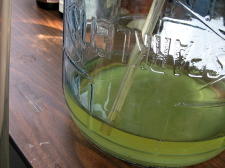
Bottling our Chardonnay by hand … and mouth

A year of waiting and worrying and almost kind-of nearly losing an eye has passed, and it’s time to roll out those barrels (ok, carboys) and flashback to 325 A.D. Yep, we’re doing it all by hand—with a little help from my mouth, as I’ve somehow become a confident siphon-starter (this wasn’t always so).
No automated assembly line of motorized fillers and pneumatic cork compressors for Team Wine. Just a bunch of friends ready and willing to work for a few sips of Chardonnay along the way. Here’s part 1 of how it all went down (next week, I’ll tell you how to stick a cork in it—no offense, of course).
We picked a finally cool fall day for bottling our Chard, to be easy on our wine and on ourselves, as we had three 5-gallon carboys of Chardonnay to transfer into 78 Burgundy-style bottles, a half-day of what would have been super-sweaty work in this year’s long-lingering Indian summer.
Fellow cellar rat Sara Jamison and I headed for our parking lot “work area,” as it’s paved and has a drain and a hose-rigged spigot for easy cleaning and clean-up. We dragged out a hefty work table (sturdy enough to hold up a heavy glass carboy); nonreactive (so not aluminum) stainless steel bowls for sterilizing our siphon tubing, bottle filler, and corks and for mixing up bottle wash*; two bottle rinsers (aka Vinators); and our Charlie Brown–esque “bottle tree” drying rack—check it out in the video below. *Whip up your own batch of bottle wash (potassium metabisulfite dissolved in water) and get a complete list of materials you’ll need by downloading our free PDF. We’ve updated it with full bottling details.
[youtube=
]And then we dragged out 6 1/2 cases of empty bottles. Home winemaker and retired chemist Dan Brenzel, our major benefactor and advice giver (and hubby of Sunset garden editor Kathy Brenzel), had run them through the dishwasher sans detergent (we didn’t want any chemical remnants leeching into our wine). But then they sat in boxes for months.
So to make sure they were wine-ready, we gave each one a rinse with bottle wash: Two pumps on one spring-loaded bottle rinser to wash away any dust, then two pumps on our second rinser to complete the sterilization (some home winemakers—like Dan—dump SO2 into their wine before bottling to really keep the bugs out, but Team Wine likes to keep interventions to a minimum). Then onto the tree for 10 to 15 minutes of drying.
[youtube=
]We got a good rhythm going, and before we knew it, the tree was full of clean bottles, ready to fulfill their destiny. At this point, the rest of Team Wine had broken away from their desk jobs to join us. And since I’ve now had a bunch of practice starting (and failing) siphons, I was easily convinced to unstopper a carboy and fill our first bottle.
Starting a siphon is all about sucking it up: You stick one end of plastic tubing way down into a carboy (as close to the tiny amount of remaining sediment as you dare), then put the other end in your mouth. Pretend like you’ve got a giant flexy straw in your mouth (mmm, remember those mondo Pixy Stix?), and start sipping. The wine will quickly start flowing, so keep a hand near your mouth to quickly and firmly pinch the tubing before wine tumbles into your mouth (this is not a beer helmet, people).
[youtube=
]Holding up the tubing end that was just in your mouth, grab your bottle filler (a plastic or metal rod with a spring-loaded tip that controls the flow of wine; I like the clear-plastic one I’m using in the above video). Gently but firmly slide the rod onto the tubing, and you’re set. As long as you keep the rod end lower than the carboy that’s up on the table, your siphon is ready whenever you are. And in the meantime, no runs, drips, or errors—this ingenious invention is liberating! (At least it is for someone who had trouble racking, as I did.)
When you’re ready, take a bottle off the tree and place it at your feet. Then squat down and poke the bottle-filling rod into the bottle. As soon as you depress its tiny tip, the rod will allow wine to pass into the bottle. Fill the bottle till it’s approaching full, pausing to let the wine foam as needed (this is normal—it’s just the SO2 bubbling off), then gently lift up and remove the rod when the wine crests the top of the bottle neck (a quality rod neatly displaces the perfect amount of headspace for your cork). You have just filled a bottle of wine—almost as easily as you’ll drain it when you’re ready to share it.
This is when having a couple of friends over will come in handy: Ask them to start a bottle brigade. One of them can be in charge of placing an empty bottle at your feet and taking a full bottle to the person working the floor corker. (Dan likes to fill a whole case of bottles at once and heft it over to the corker, but we found this to be far messier, spill-inducing, and disaster-tempting than we were comfortable flexing our muscles for.) At the end of each carboy, rotate jobs to see what they’re all like.
Curious about corking? Tune in next week for video of the beloved but rickety floor corker that sealed our Chardonnay’s fate.

